
Xinle culture
Encyclopedia
The Xinle Civilization (5500-4800 BC) was a Neolithic
culture in northeast China
, found primarily around the lower Liao River
on the Liaodong Peninsula in Liaoning
. The culture showed evidence of millet
cultivation and pig domestication. The type site
at Xinle was discovered in the Huanggu District
of Shenyang
, Liaoning
.
The site is named after an old inn, in which grounds the remains were first discovered.
, the original name has prevailed.
In 1978 another dig uncovered yet more artifacts including one wooden carving that was some 7200 years old, presumably a type of totem
worshipped by the clan. No other find in the whole of Shenyang
has been older, the find is also one of the oldest wooden carvings found anywhere in the world.
The excavations also discovered two Khitan
tombs from 1000 years ago.
The museum is divided into two sections, north and south. The southern section contains displays of the various artifacts unearthed during the various excavations that have taken place on 44 acres (178,061.8 m²) site. The northern section contains a reconstruction of a 7000 year old Xinle village. Some of the houses in the settlement contain representations of life 7000 years ago.
Neolithic
The Neolithic Age, Era, or Period, or New Stone Age, was a period in the development of human technology, beginning about 9500 BC in some parts of the Middle East, and later in other parts of the world. It is traditionally considered as the last part of the Stone Age...
culture in northeast China
China
Chinese civilization may refer to:* China for more general discussion of the country.* Chinese culture* Greater China, the transnational community of ethnic Chinese.* History of China* Sinosphere, the area historically affected by Chinese culture...
, found primarily around the lower Liao River
Liao River
The Liao River is the principal river in northeast China . The province of Liaoning and the Liaodong Peninsula derive their names from the river....
on the Liaodong Peninsula in Liaoning
Liaoning
' is a province of the People's Republic of China, located in the northeast of the country. Its one-character abbreviation is "辽" , a name taken from the Liao River that flows through the province. "Níng" means "peace"...
. The culture showed evidence of millet
Millet
The millets are a group of small-seeded species of cereal crops or grains, widely grown around the world for food and fodder. They do not form a taxonomic group, but rather a functional or agronomic one. Their essential similarities are that they are small-seeded grasses grown in difficult...
cultivation and pig domestication. The type site
Type site
In archaeology a type site is a site that is considered the model of a particular archaeological culture...
at Xinle was discovered in the Huanggu District
Huanggu District
Huanggu District is a district of Shenyang, the capital of Liaoning province, People's Republic of China.-Administrative Divisions:There are 20 subdistricts within the district.Subdistricts:...
of Shenyang
Shenyang
Shenyang , or Mukden , is the capital and largest city of Liaoning Province in Northeast China. Currently holding sub-provincial administrative status, the city was once known as Shengjing or Fengtianfu...
, Liaoning
Liaoning
' is a province of the People's Republic of China, located in the northeast of the country. Its one-character abbreviation is "辽" , a name taken from the Liao River that flows through the province. "Níng" means "peace"...
.
The site is named after an old inn, in which grounds the remains were first discovered.
Naming
The site of the ancient settlement was discovered in the grounds of an old accommodation block for an electrical factory. The accommodation block was called the Xinle Dormitory (新樂宿舍) and hence the discovery was named the Xinle Relic. When it was discovered that the settlement was that of a hitherto unknown civilization, the whole civilization was named after the relic and hence became known as the Xinle civilization. Although more recent discoveries in nearby areas have been extremely significant, especially one in XinminXinmin
Xinmin is a city in Liaoning province, People's Republic of China. It is a county-level city under the administration of Shenyang, the provincial capital.-Administrative Divisions:...
, the original name has prevailed.
Excavations
In 1973, excavations at the site discovered evidence for some 40 neolithic houses. Artifacts uncovered during the dig included stone tools, pottery, jade, bone tools, wood carvings and refined coal.In 1978 another dig uncovered yet more artifacts including one wooden carving that was some 7200 years old, presumably a type of totem
Totem
A totem is a stipulated ancestor of a group of people, such as a family, clan, group, lineage, or tribe.Totems support larger groups than the individual person. In kinship and descent, if the apical ancestor of a clan is nonhuman, it is called a totem...
worshipped by the clan. No other find in the whole of Shenyang
Shenyang
Shenyang , or Mukden , is the capital and largest city of Liaoning Province in Northeast China. Currently holding sub-provincial administrative status, the city was once known as Shengjing or Fengtianfu...
has been older, the find is also one of the oldest wooden carvings found anywhere in the world.
The excavations also discovered two Khitan
Liao Dynasty
The Liao Dynasty , also known as the Khitan Empire was an empire in East Asia that ruled over the regions of Manchuria, Mongolia, and parts of northern China proper between 9071125...
tombs from 1000 years ago.
Museum
In 1984 the Museum of the Xinle Civilization (新樂遺址博物館) was founded.The museum is divided into two sections, north and south. The southern section contains displays of the various artifacts unearthed during the various excavations that have taken place on 44 acres (178,061.8 m²) site. The northern section contains a reconstruction of a 7000 year old Xinle village. Some of the houses in the settlement contain representations of life 7000 years ago.
Gallery
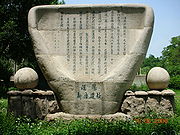 |
 |
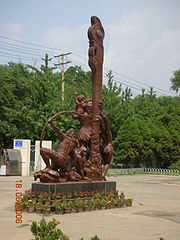 |
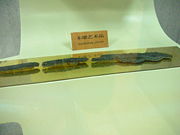 |
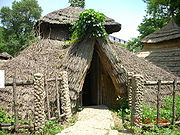 |
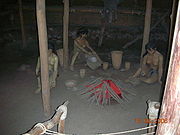 |

